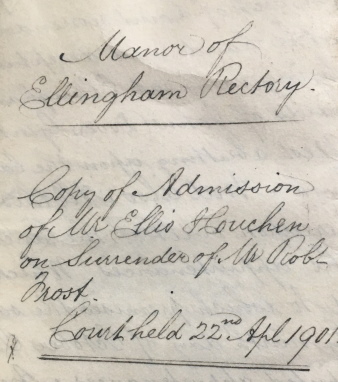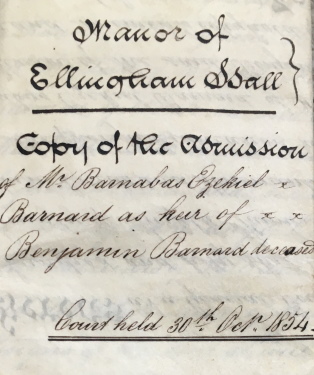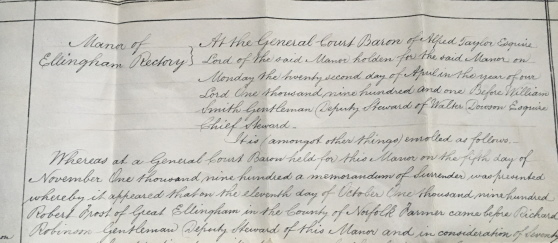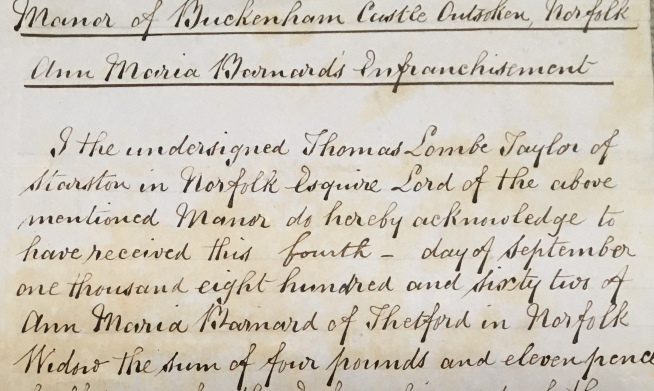


Manor of Bury Hall. Extract from 1867 copy Admission of James Matthews. Courtesy of Lucinda Bell-Tye.
Manor of Ellingham Rectory. Extract from 1901 copy Admission of Ellis Houchen. Author’s personal collection.
Manor of Ellingham Hall. Extract from 1854 copy Admission of Barnabas Ezekiel Barnard. Author’s personal collection.
Copyhold Title
Before the abolition of copyhold title by the Law of Property Act 1922, there were three main forms of property ownership in England during the post-medieval period: Freehold, Leasehold and Copyhold.
Copyhold title was a form of ownership which was initially an occupation of land at the pleasure of the Lord of the Manor and which bound the copyhold tenants to the Manor. Over time this occupation became an occupation as of right, but it was still subject to the customs of the particular Manor.
These customs would include the rules and procedures for a change of ownership. On the sale/purchase or other acquisition of copyhold land (for example by inheritance), the Lord of the Manor would have to be notified and the parties involved would be obliged to attend at the relevant Manor Court. These Courts dealt with the administration of the Manor and were held several times during the year by the Lord – or, more often, by his Steward or Deputy Steward.
The circumstances of the transaction would be set out at the Manor Court. The outgoing copyhold tenant would ‘surrender’ the property back to the Lord and the purchaser, also attending the Court, would be ‘admitted’ as the new copyhold tenant with any fines (payments) having been made to the Court.
Details of the transaction would be entered onto the Court Rolls (or Court Books) which recorded the activities of the Manorial Court. A copy of the ‘Admission’ deed would given to the new copyhold tenant.

Manor of Ellingham Rectory. Extract from a Copy of an Admission of Ellis Houchen. Court Held 22nd April, 1901. From author’s personal collection.
Three Manors of Great Ellingham
Land within a village or town can lie within more than one Manor. Great Ellingham had three Manors: Ellingham Rectory, Ellingham Hall and, the largest, the Manor of Bury Hall. However there were parcels of land and property within the village which were copyhold of other Manors.
Villagers may have owned various pieces of land or property which was copyhold of more than one Manor. Accordingly the individuals would have to approach the Lord of each of the respective Manors in order to deal with a change of ownership of all their copyhold land and property.
Land in Great Ellingham Copyhold of other Manors
The Statement of Claims for the Great Ellingham Inclosures c.1800, refers to certain property and pieces of land in Great Ellingham being copyhold of one of the following Manors:
Ellingham Hall, Ellingham Rectory, Bury Hall, Buckenham Castle Outsoken, Buckenham Lathes Outsoken, Buckenham Close Outsoken and Attleburgh Mortimers.
Lords of the Manors in Great Ellingham
In 1800, the Reverend Francis Colman Negus was the Lord of the Manor of Ellingham Hall. The building called Ellingham Hall was occupied by Robert Barnard. The Reverend Negus was also the Lord of the Manor of Ellingham Rectory. Thomas, Lord Walsingham was the Lord of Bury Hall Manor. Bury Hall itself was occupied by James Barnard.
In 1864, Thomas Lombe Taylor was Lord of the Manors of Ellingham Rectory and Ellingham Hall, and Lord Walsingham the Lord of the Manor of Bury Hall, albeit now the 5th Baron Walsingham.
By 1896, Alfred Taylor Esquire of Starston Place, near Harleston was Lord of the Manors of Ellingham Rectory and Ellinghall Hall. The 6th Baron, Lord Walsingham was the Lord of the Manor of Bury Hall.
The holders of the Lordships of the three Manors in Great Ellingham remained the same until at least 1937. However by that time, some 15 years after the abolition of copyhold title, there were unlikely to be many properties or pieces of land (if any) still in copyhold ownership.
Copyhold to Freehold
Even before the abolition of copyhold title, copyhold tenants could pay a consideration (payment) to the Lord of the Manor for the enfranchisement of their copyhold land which the Lord would then release from the copyhold customs. The land would revert to freehold tenure (or, in some cases, held on a long lease).

Extract from 1862 Memorandum of Enfranchisement. Manor of Buckenham Castle Outsoken concerning lands held by Ann Maria Barnard of Thetford. Author’s personal collection.
On the 4th September 1862, Thomas Lombe Taylor, the Lord of the Manor of Buckenham Castle Outsoken, acknowledged the sum of four pounds and eleven pence half-penny from Ann Maria Barnard of Thetford, widow, for the enfranchisement of lands held by Mrs Barnard as copyhold tenant.
Ann Barnard had been admitted as a copyhold tenant of the Manor on the 19th February 1862 in succession to her deceased husband. The Lord of the Manor discharged Mrs Barnard from ‘all Rent, Charges, Fines, Heriots, Reliefs, Quit Rents and all other Incidents whatsoever of Copyhold or Customary Tenure‘ and the land reverted to freehold from that date. Thereafter, Ann Barnard was free to dispose of the land as she so wished free from the customs of the Manor of Buckenham Castle Outsoken.
Sources:
Inclosure Commissioner’s Particulars & Valuation Great Ellingham 1800 held at the Norfolk Record Office catalogue reference MC 2213/119, 941X7
1864 White’s Directory. Attleborough Heritage Group, Attleborough Community & Enterprise Centre, Church Street, Attleborough, NR17 2AH
1896 Kelly’s Directory
1925 Kelly’s Directory. Attleborough Heritage Group.
1937 Kelly’s Directory. Attleborough Heritage Group.
McLaughlin, Eve. 1996. A McLaughlin Guide Manorial Records.
Encyclopaedia Britannica. https://www.britannica.com/topic/copyhold Accesed 18.02.2020
1862, 4th September. Memorandum of Enfranchisement. Manor of Buckenham Castle Outsoken. Ann Maria Barnard. Author’s Personal Collection